Bats of Westchester
Have you looked into the twilight sky and seen the quick, agile silhouettes of bats in flight? For some it can be frightening to see bats nearby, but take heart. These amazing little hunters use their keen eyesight and powerful echolocation to find prey and stay away from humans. While there are 1,400 species of bats in the world, only nine call New York home. Do you know your bat neighbors?
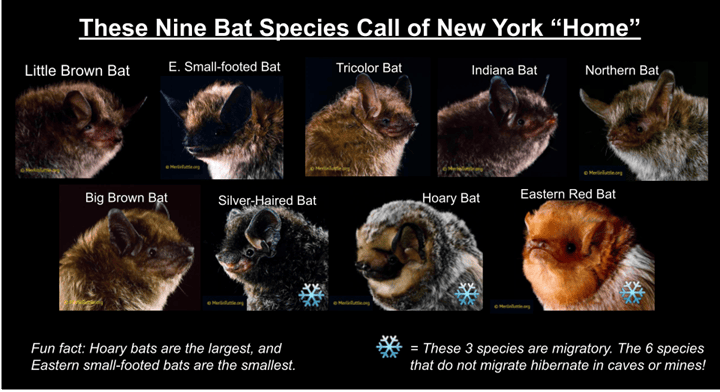
If not, don’t worry, most people don’t. To start with some basics, bats are mammals and all nine of New York’s bat species are insectivores, which means that they eat insects. That’s right, no vampire bats here. In fact, there are very few species of vampire bats (only three out of 1,400), and they all live in Mexico and South and Central America. Other species of bats across the globe eat insects, small animals like fish, fruit, or nectar. But let’s get back to our local neighbors.
Of the nine species in New York, three are migratory: silver-haired bats, eastern red bats, and hoary bats. One of the challenges faced by these migratory species, especially hoary bats, is the threat of wind turbines. While wind turbines are an excellent source of renewable energy, bats cannot detect the low-pressure areas created around the blades of the turbines as they spin. As bats fly into these low-pressure zones, they suffer internal injuries referred to as “barotrauma”. Scientists are investigating ways to reduce the impact of wind turbines on migratory animals, including warning beacons on the blades and reducing turbine activity during peak migration times.
The six species of bats that do not migrate all hibernate in caves or mines. In 2006, a fungus called White Nose Syndrome (WNS) became a huge problem for hibernating bats in New York, especially little brown bats and eastern small-footed bats. This fungus attacks the skin and respiratory system of the bats, weakening them over the winter and typically leading to death by springtime. The impacts of WNS are so extreme that in some infected colonies, over 90% of individuals have died. White Nose Syndrome has spread across the continent, and little brown bats and Eastern small-footed bats are now on the IUCN endangered species list due to it. You can help stop the spread of White Nose Syndrome by carefully cleaning any hiking gear and clothing between visits to caves, and by staying out of caves that have been marked as sensitive bat habitat.
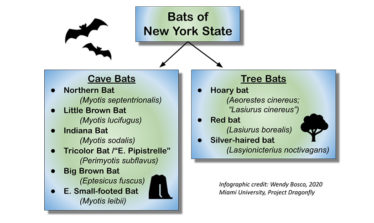
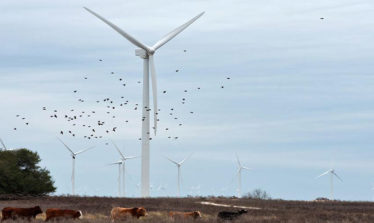
Unfortunately, wind turbines and WNS aren’t the only threats to bats. Habitat loss and fear over bats’ roles in COVID-19 have also led to population declines. Luckily, you can help with these problems, too! When it comes to COVID and bats, understand that while bats can harbor diseases, no bat species have been proven to have transmitted COVID to humans. Learn more and help educate others about bats and COVID to help eliminate unnecessary fears that bats are to blame (Merlin Tuttle’s Bat Conservation and Bat Conservation International are excellent resources)
To help bats with habitat loss, consider leaving “snags” (dead trees) standing on your property as long as it’s safe to do so. When they come out of hibernation or return from migration, bats love to use snags to raise their pups in the spring and summer. You can also install a bat house! Bat houses are like birdhouses – they’re artificial homes that bats can use when safe places like dead trees aren’t available. Teatown hosted a wonderful bat box building program on April 17th! If you don’t want to build your own bat house, you can also buy one. This website is a great place to find safe, effective bat houses. Bats play a crucial part in Westchester’s ecosystems by keeping insect populations under control, and as prey to predators like owls and snakes. Get to know more about these little mammals here. You may be surprised by how much you’ll grow to love your batty neighbors!
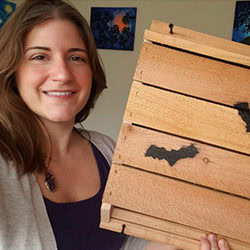
About the Author
Wendy Boscoe
Graduate Student and Biology Teacher
Wendy has been researching bats and conservation through her graduate studies with Miami University. She holds a BS in Biology from SUNY Buffalo and an MS in Science Education from the University of Bridgeport. Wendy is an avid hiker and nature lover, and has been happy to host several bat events with Tea Town this year including the bat box building event!


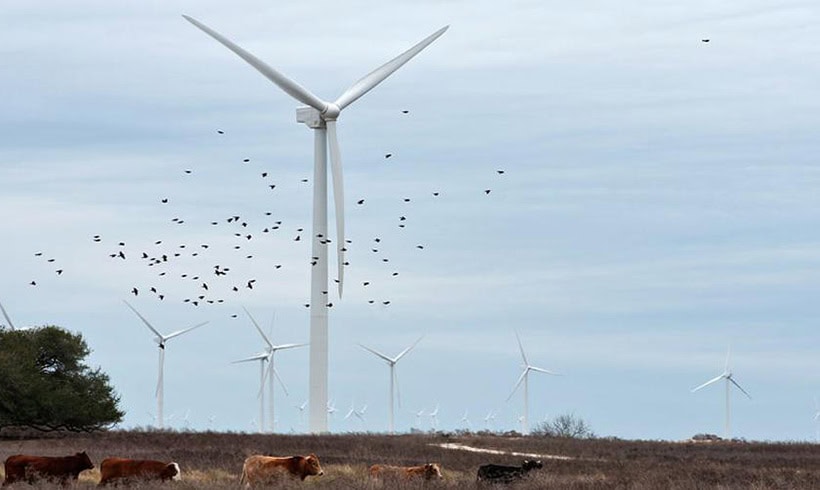
Leave a Reply